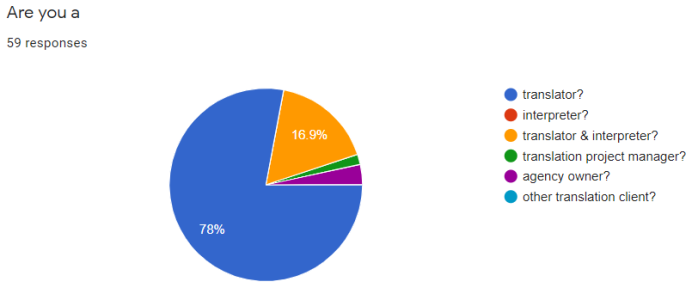 Back in February last year, I asked you all to answer some questions about translation qualifications in a survey. I kept extending the deadline because I was hoping for more responses. And then when I should have being doing a write-up of the results, Brexit and the UK general election, family issues and the ever-present threat of the climate emergency filled my head and my spare time leaving me with no energy or enthusiasm for the blog.
Back in February last year, I asked you all to answer some questions about translation qualifications in a survey. I kept extending the deadline because I was hoping for more responses. And then when I should have being doing a write-up of the results, Brexit and the UK general election, family issues and the ever-present threat of the climate emergency filled my head and my spare time leaving me with no energy or enthusiasm for the blog.
Now that we’re in the midst of a global pandemic, my work has all but come to a halt so at least I can finally get around to thanking everyone who took part in the survey and giving you the results.
As there were only 59 respondents and I imagine this post might make some colleagues want to give their views, I have reopened the survey and will continue accepting responses until the end of July 2020.
As you can see from the first pie chart above, the vast majority (46 respondents) are translators. Only one translation project manager and two agency owners filled in the survey, so it would be extremely helpful if more clients and PMs gave their views.
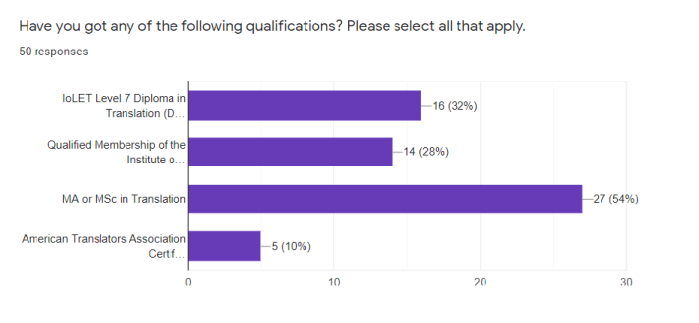
Almost half of the survey respondents have an MA or an MSc in Translation. Just under a third have passed the CIOL Level 7 Diploma in Translation exam (commonly known as the DipTrans), and around a quarter are qualified members of the Institute of Translating and Interpreting (MITIs). Lastly, only five respondents have ATA certification.
None of the respondents had all four qualifications, although one had three (DipTrans, MITI and ATA certified). Three had DipTrans and were MITIs, another three had DipTrans and an MA or MSc, and a final three were MITIs with an MA or MSc. Only one person was ATA certified and had a master’s degree.
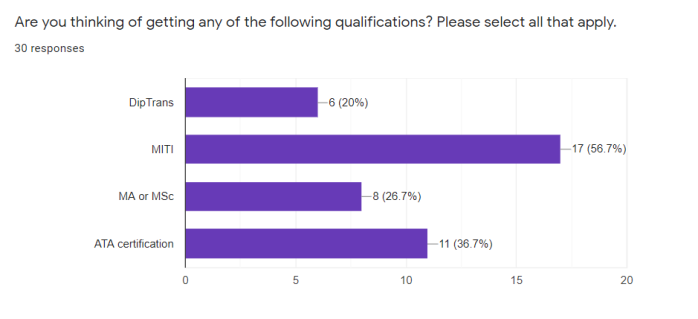
The picture changes when the respondents detail the qualifications they would like to achieve, with MITI in first place followed by ATA certification in second and DipTrans as the least chosen.
Only two respondents selected three qualification options in this section. Both showed an interest in becoming an MITI and in studying for an MA or MSc in Translation with one wishing to add the DipTrans and the other ATA certification.
The most popular combination of two qualifications was MITI and ATA certification (four respondents). However, three respondents paired the DipTrans with one of the other qualifications.
Out of those selecting to put only one qualification on the wish list, ten chose MITI, four an MA or MSc, four ATA certification and only two the DipTrans.
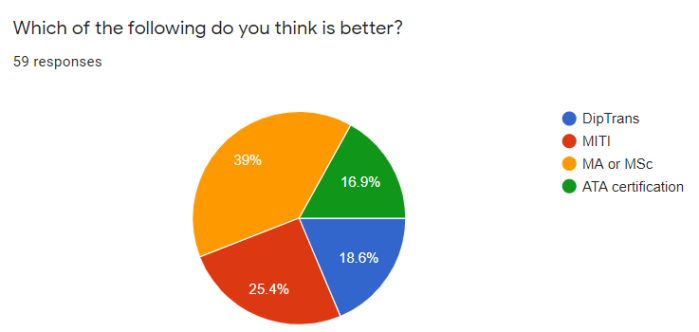 Looking at the second pie chart, we can observe that 39% of the respondents think a master’s degree is a better qualification to have than the other three, followed by MITI in second place with just over 25%.
Looking at the second pie chart, we can observe that 39% of the respondents think a master’s degree is a better qualification to have than the other three, followed by MITI in second place with just over 25%.
In Part 2 of these survey results, I’ll detail some of the responses I received to explain people’s choices. I appreciate that some respondents didn’t know what to put and so chose a random answer they were familiar with because there was no “don’t know” option. There still isn’t, but you can skip these questions if you wish and just write a long answer instead.
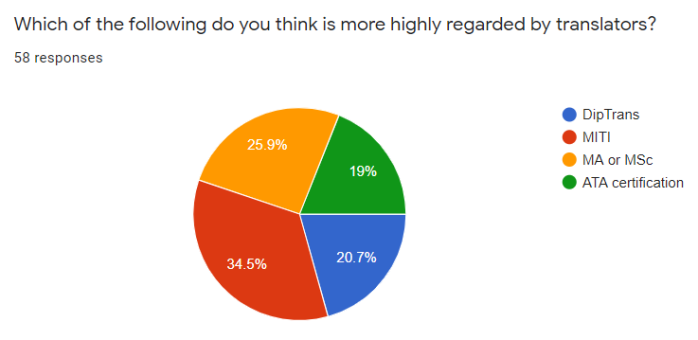 Interestingly, although the respondents think an MA or MSc in Translation is the best qualification to have out of the four, they think that the MITI is more highly regarded by translators.
Interestingly, although the respondents think an MA or MSc in Translation is the best qualification to have out of the four, they think that the MITI is more highly regarded by translators.
The ATA certification was again in last place, although this might be because most of the respondents are based in Europe and so haven’t achieved ATA certification or considered taking the exam.
Personally, I was surprised to see the DipTrans in third place since, given it’s so hard to pass the exam, I was expecting it to come out on top.
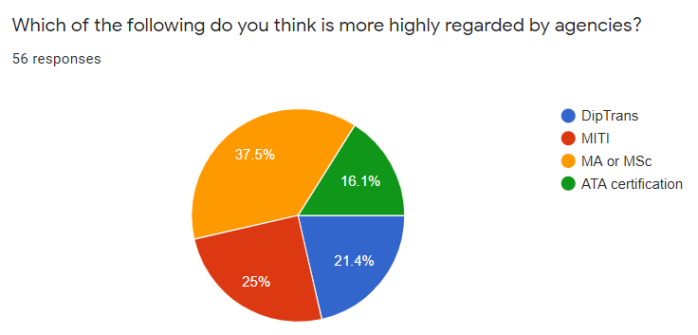 The pie chart showing the results to the question “Which of the following do you think is more highly regarded by agencies?” has very similar percentages to the one showing which qualifications the respondents think are best.
The pie chart showing the results to the question “Which of the following do you think is more highly regarded by agencies?” has very similar percentages to the one showing which qualifications the respondents think are best.
The DipTrans is still surprisingly, for me anyway, in third place but with a slightly higher share than above.
The respondents’ explanations for their choices range from having no real idea of agencies’ preferences to their experience of qualifications they have been asked for. Again, I will provide details in a later post.
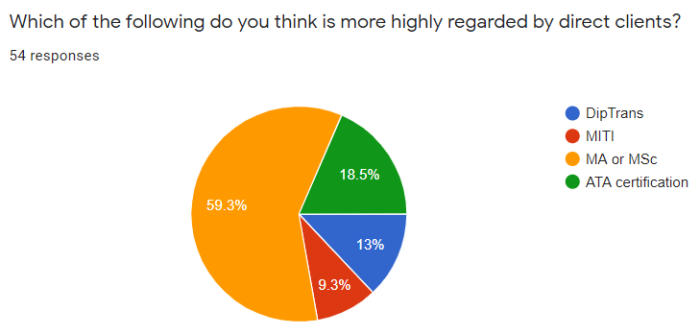 When asked the last question on which qualification direct clients might regard more highly, most respondents chose an MA or MSc in Translation because clients understand what this means but will probably not know anything about the other qualifications.
When asked the last question on which qualification direct clients might regard more highly, most respondents chose an MA or MSc in Translation because clients understand what this means but will probably not know anything about the other qualifications.
I hope you’ve found these results of interest. Please see Part 2 for more details and respondents’ comments.
Explore this blog by starting with the categories page., which includes a section on all the surveys I’ve run.

Hi Nikki. I now can’t remember whether or not I filled in this one – certainly I don’t remember doing it. Is there any way of checking, i.e. will the survey tell me I’ve already done it if I try to do it again?
LikeLiked by 1 person
I don’t know. I don’t think it’ll stop you from doing it twice. Don’t worry if you have and want to complete it again. You might answer differently now that it’s a year later and after reading the results.
LikeLiked by 1 person